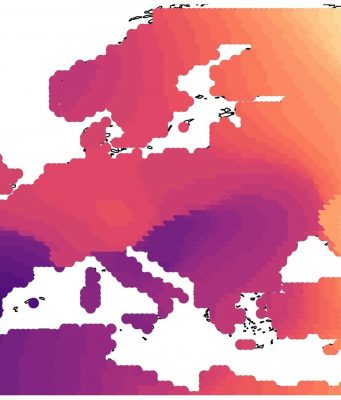A 3,000-year-old burial in the Pacific Island nation of Vanuatu that is source of one of the ancient DNA samples reported on in this study. It is a triangular bone arrangement, with skulls at each vertex, lying on the...
Ancient artifacts found at an archeological site in Argentina suggest that humans occupied South America earlier than previously thought.
Approximately 13,000 years ago, a prehistoric group of hunter-gathers known as the Clovis people lived in Northern America. Previous research suggests...
Tympanic membrane (grey), ossicular chain (yellow, green, red), and bony inner ear (blue) of a modern human with a One-Eurocent coin for scale.© A. Stoessel & P. Gunz
A research team led by scientists of the Max Planck Institute for...
This is Lucy, a 3.18 million year old fossil specimen of Australopithecus afarensis.Credit: Image provided by John Kappelman, UT Austin
Lucy, the most famous fossil of a human ancestor, probably died after falling from a tree, according to a study...
A UCLA study is the first to show that Latinos age at a slower rate than other ethnic groups. The findings, published in the current issue of Genome Biology, may one day help scientists understand how to slow the...
A new public searchable database provides access to a unique and inspirational treasure trove of amazing stories and pictures through what Lancaster University researchers term the 'social media' of the Edwardian era.
Described by researchers at Lancaster University as the...
These are 2,000-year-old personal hygiene sticks with remains of cloth, excavated from the latrine at Xuanquanzhi. Credit: Hui-Yuan Yeh. Reproduced from the Journal of Archaeological Science: Reports.
An ancient latrine near a desert in north-western China has revealed the first archaeological...
Neanderthal depiction (stock image). Neanderthals lived in the Middle Paleolithic, the middle period of the Old Stone Age. This period encompasses the time from roughly 200,000 to 40,000 before our times.
Credit: ©erix/ Flickr
Neanderthals once populated the entire European continent....
Researchers working inside the Klipdrift complex. Credit: Magnus Haaland
Environmental records obtained from archaeological sites in South Africa's southern Cape suggest climate may not have been directly linked to cultural and technological innovations of Middle Stone Age humans in southern...
The shapes of the fossil and modern footprints are nearly indistinguishable.Credit: Kevin Hatala / Max Planck Institute for Evolutionary Anthropology
Fossil bones and stone tools can tell us a lot about human evolution, but certain dynamic behaviours of our fossil...
Our ancestors evolved three times faster in the 10 million years after the extinction of the dinosaurs than in the previous 80 million years, according to UCL researchers.
The team found the speed of evolution of placental mammals -- a...














